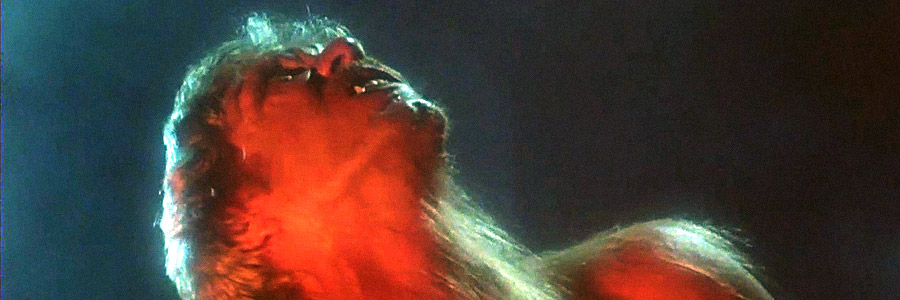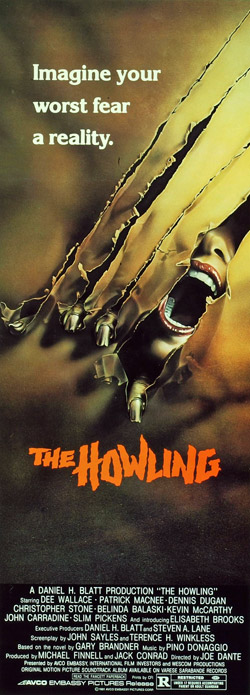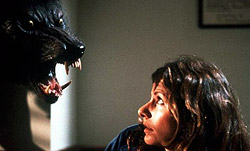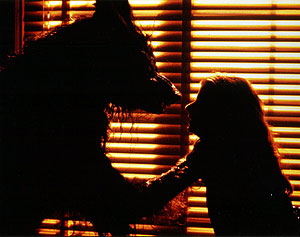
The Howling

THE HOWLING (MOVIE)
MGM
Original release: April 10th 1981
Running time: 91 minutes
Director: Joe Dante
Writers: John Sayles, Terence H. Winkless
Cast: Dee Wallace, Christopher Stone, Robert Picardo, Patrick Macnee

I’ve said it before and I’ll say it again: I hate Twilight. Not only has it turned vampires into glittery freaks but it’s basically assassinated the werewolf genre too – anyone who’s seen Red Riding Hood (2011) will know what I mean. It’s the creation of CGI and the ‘style over substance’ trend, which has acted as a silver bullet to what would be a promising sub-genre.
The 1980s on the other hand didn’t have this problem. Werewolf films were common in this decade. Films such as An American Werewolf in London (1981), The Beast Within (1982) and Silver Bullet (1985) depicted the struggles of separating man vs. beast and captivated audiences with their stories and effects. Even Michael Jackson joined in on the craze with his Thriller (1985) music video. One of the most popular werewolf films is the 1981 cult classic The Howling.
Directed by Joe Dante, the film centres on Karen White (Dee Wallace), a television anchorwoman, who takes part in a dangerous police operation to trap Eddie Quist (Robert Picardo), a twisted serial killer who has been stalking her. When she meets him face to face in a seedy porn theatre, she witnesses something horrifying enough to trigger selective amnesia. Suffering from terrifying nightmares, Karen admits herself for treatment into “The Colony”, a secluded recovery retreat in the countryside run by Dr. George Waggner (Patrick Macnee), an eccentric New Age therapist, and brings husband Bill Neill (Christopher Stone) along for support.
The locals appear strange to Karen, as they seem far too eager to make her feel at home. There also appears to be a bizarre link between Eddie and this supposedly safe haven. After being tormented by shrieks, cries and howling at night, Karen searches for answers in the forest where she makes a disturbing discovery.
Now she must not only fight for her sanity but for her life and soul.
Vaguely based on the 1977 novel by Gary Brandner of the same name, The Howling

Dante and screen writer John Sayles, who had previously collaborated on Piranha (1978), working with fellow screen writer Terence H. Winkless created a film that kept the same self-awareness, satirical tone and included many in-joke subtle references to wolves via cartoons, books, a brand of food known as ‘Wolf Brand Chilli’ and pictures decorating the inside of Karen and Bill’s cabin. They also paid tribute to earlier werewolf films by naming characters after the films’ directors for example, George Waggner (The Wolf Man, 1941) and Terence Fisher (The Curse of the Werewolf, 1960). It also featured cameos by Sayles, Roger Corman (Dante’s former producer) and Forrest J. Ackerman.
With the transformation SFX created by Rob Bottin (who also worked on Piranha, 1978 and The Thing, 1982) it was one of the first lycanthrope films to show the transformation of a man/woman into a werewolf in a frightening, and for its time, realistic looking way. The hair begins to grow, faces change size and snouts extend outwards. I’m still amazed to this day how good it looks. The transformation of Eddie in particular was so effective that critics felt that the film’s climax couldn’t beat it.
The Howling changed the perception of what audiences had already seen in earlier werewolf films. The bite was no longer a curse or something that must be hidden away. It’s portrayed as a gift, which is given to a select few people to gain the primal power that a normal human could not even begin to imagine. The werewolves don’t need to wait for a full moon, they can transform in the daylight and it’s  interesting to see the politics of the lycanthropes community. Some have the future hopes of being able to fit in with society and others feel that humans are for hunting and due to their powers can dominate society. Sex is also a highly influential part of the film as one of the transformations occurs during mid-intercourse and as mentioned earlier represents our primal urges; the struggles of separating man vs. beast.
interesting to see the politics of the lycanthropes community. Some have the future hopes of being able to fit in with society and others feel that humans are for hunting and due to their powers can dominate society. Sex is also a highly influential part of the film as one of the transformations occurs during mid-intercourse and as mentioned earlier represents our primal urges; the struggles of separating man vs. beast.
While the film was a success, it was overshadowed by the bigger budgeted and more mainstream John Landis film An American Werewolf in London (1981), which is regarded as one of the best werewolf films of all time. If both films weren’t released around the same time then I believe The Howling would have been even more successful.
But of course with every successful film a sequel follows. Six, in fact tried to make The Howling become a popular franchise. They did the opposite, as they were all dreadful. Believe me I wouldn’t waste your time on them. With the seventh entry titled The Howling: Reborn (2011) soon to be released in the UK (direct-to-DVD) I dread to think what it will be like. The trailer looks very much Twilight homoerotic inspired. If I were Joe Dante I would have already begun my Kill Bill-esque vengeance on everyone who was involved in the films.
- (1) Dixon, Wheeler Winston, A History of Horror (2010), Rutgers University Press
Being the second werewolf film I had seen, following Silver Bullet (1985), I loved it as a child. I was scared but what child wouldn’t be scared of werewolves? A full moon shining through your window is eerie enough as it is. The transformation scenes amazed me and gave me another reason to keep the curtains closed. Nowadays I still love it and spend the duration of the film trying to figure out the past horror film references and which of the characters ‘directed’ which film.
Over the years, The Howling hasn’t dated very well. However, it’s cheesy, doesn’t take itself too seriously and keeps you entertained throughout. What more could you ask for? Don’t say Twilight.

Jamie Suckley
Jamie, editor for Cult Movies at Static Mass, is a 24 year old media studies graduate from Sheffield, who likes nothing better than watching films. If he was to star in a horror film he’d like to be the first one killed (think Drew Barrymore in Scream).
He has a keen interest in horror which started when he was a child. Due to his hyperactive behaviour his cousins made him watch films they thought would calm him down- They were wrong! It was watching Hellraiser and Killer Klowns from Outer Space that his passion for horror began. Over the years this developed into a passion for zombies, madmen, mutated animals and all things gore.
When he’s not working, in his dream world, worrying about zombie epidemics or watching films, he can be found on Twitter sharing his thoughts and bringing his dream world into reality.
You can follow Jamie on Twitter @JamieSuckley.
© 2022 STATIC MASS EMPORIUM . All Rights Reserved. Powered by METATEMPUS | creative.timeless.personal. | DISCLAIMER, TERMS & CONDITIONS
HOME | ABOUT | CONTACT | TWITTER | GOOGLE+ | FACEBOOK | TUMBLR | YOUTUBE | RSS FEED
CINEMA REVIEWS | BLU-RAY & DVD | THE EMPORIUM | DOCUMENTARIES | WORLD CINEMA | CULT MOVIES | INDIAN CINEMA | EARLY CINEMA
MOVIE CLASSICS | DECONSTRUCTING CINEMA | SOUNDTRACKS | INTERVIEWS | THE DIRECTOR’S CHAIR | JAPANESE CINEMA





